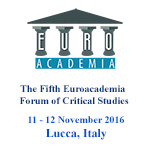Euroacademia Conferences
 Europe Inside-Out: Europe and Europeanness Exposed to Plural Observers (9th Edition) April 24 - 25, 2020
Europe Inside-Out: Europe and Europeanness Exposed to Plural Observers (9th Edition) April 24 - 25, 2020 Identities and Identifications: Politicized Uses of Collective Identities (9th Edition) June 12 - 13, 2020
Identities and Identifications: Politicized Uses of Collective Identities (9th Edition) June 12 - 13, 2020 8th Forum of Critical Studies: Asking Big Questions Again January 24 - 25, 2020
8th Forum of Critical Studies: Asking Big Questions Again January 24 - 25, 2020 Re-Inventing Eastern Europe (7th Edition) December 13 - 14, 2019
Re-Inventing Eastern Europe (7th Edition) December 13 - 14, 2019 The European Union and the Politicization of Europe (8th Edition) October 25 - 26, 2019
The European Union and the Politicization of Europe (8th Edition) October 25 - 26, 2019 Identities and Identifications: Politicized Uses of Collective Identities (8th Edition) June 28 - 29, 2019
Identities and Identifications: Politicized Uses of Collective Identities (8th Edition) June 28 - 29, 2019 The European Union and the Politicization of Europe (7th Edition) January 25 - 26, 2019
The European Union and the Politicization of Europe (7th Edition) January 25 - 26, 2019 7th Forum of Critical Studies: Asking Big Questions Again November 23 - 24, 2018
7th Forum of Critical Studies: Asking Big Questions Again November 23 - 24, 2018 Europe Inside-Out: Europe and Europeanness Exposed to Plural Observers (8th Edition) September 28 - 30, 2018
Europe Inside-Out: Europe and Europeanness Exposed to Plural Observers (8th Edition) September 28 - 30, 2018 Identities and Identifications: Politicized Uses of Collective Identities (7th Edition) June 14 - 15, 2018
Identities and Identifications: Politicized Uses of Collective Identities (7th Edition) June 14 - 15, 2018
Mediating the Periphery: Borgata Gordiani from Interwar to Postwar Rome
-
-

-
Presentation speakers
- Anna Mascorella, Department of Architecture, Cornell University, USA
Abstract:
Located in the undeveloped countryside that comprised Rome’s periphery, Borgata Gordiani was among the earliest’and worst’social housing efforts developed under Italy’s Fascist regime. Built in the early 1930s, the project formed a makeshift neighborhood consisting of rows of brick shacks intended as temporary housing for the rural migrants, urban poor, and lower-working-class families who were deliberately displaced from Rome’s historic center by the regime’s renovation of the city. However, the inhabitation of the Borgata extended well beyond its Fascist-era inception and intention. Continually occupied until 1980, Borgata Gordiani’s controversial presence has persisted through a range of imagery, both individual and institutional. These visual and verbal forms of documentation offer a means by which to enter peripheral Rome and access one of the complex narratives of its architectural and urban history. This presentation examines the trajectory of Borgata Gordiani’s development, inhabitation, and degradation through its depiction in photography, oral testimony, and film to reveal how these different types of representation construct a conflicting urban image of peripheral Rome and its transformations. Borgata Gordiani thus serves as a case study that contextualizes the legacy of Fascist urban interventions beyond Rome’s historic center and after the fall of the regime, while also articulating how external perceptions of the borgata and its inhabitants, as well as the identity of the inhabitants themselves, shaped the form and representation of their displacement. As such, this exploration sifts through layers of intention and mediation, and experience and memory to craft an account of Borgata Gordiani that extends from its interwar conception to its late-twentieth-century destruction in order to identify the broader traces of Fascism, their consequences, and their postwar perpetuation.
-
Related Presentations

Urban Space in Museum Exhibitons
- Michal Grabowski

Noumenism
- Heidi Dinkler

The Biopower of Neoliberalism
- Sebastian Ramirez













